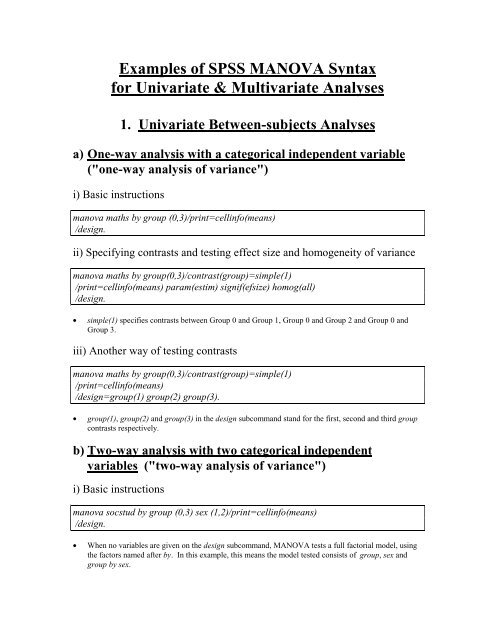
- #MULTIPLE DISCRIMINANT ANALYSIS SPSS CODE PDF#
- #MULTIPLE DISCRIMINANT ANALYSIS SPSS CODE FULL#
- #MULTIPLE DISCRIMINANT ANALYSIS SPSS CODE PC#
The "Functions at Group Centroids" tableĒ4

The "Canonical Discriminant Functions Coefficients" tableĒ3 The "Standardized Canonical Discriminant Function Coefficients" tableĒ1 The "Box's Test of Equality of Covariance Matrices" tablesđ8 The "Pooled Within-Group Matrices" and "Covariance Matrices" tables.đ8 The "Tests of Equality of Group Means" tableđ6 The "Analysis Case Processing Summary" tableđ6 SPSS Statistical output for two-group DAđ6 Click here.īelow is the unformatted table of contents.
#MULTIPLE DISCRIMINANT ANALYSIS SPSS CODE FULL#
The full content is now available from Statistical Associates Publishers. DA also assumes the dependent variable is a true dichotomy since data which are forced into dichotomous coding are truncated, attenuating correlation. Like multiple regression and most statistical procedures, DA also assumes proper model specification (inclusion of all important independents and exclusion of causally extraneous but correlated variables). To infer the meaning of MDA dimensions which distinguish groups, based on discriminant loadings.ĭiscriminant analysis has basic two steps: (1) an F test (Wilks' lambda) is used to test if the discriminant model as a whole is significant, and (2) if the F test shows significance, then the individual independent variables are assessed to see which differ significantly in mean by group and these are used to classify the dependent variable.ĭiscriminant analysis shares all the usual assumptions of correlation, requiring linear and homoscedastic relationships and untruncated interval or near interval data. To discard variables which are little related to group distinctions. To assess the relative importance of the independent variables in classifying the dependent variable. To determine the percent of variance in the dependent variable explained by the independents over and above the variance accounted for by control variables, using sequential discriminant analysis. To determine the percent of variance in the dependent variable explained by the independents. To determine the most parsimonious way to distinguish among groups. To investigate differences between or among groups. To test theory by observing whether cases are classified as predicted. To classify cases into groups using a discriminant prediction equation. There are several purposes for DA and/or MDA: Logistic regression is preferred when data are not normal in distribution or group sizes are very unequal. If the data violate assumptions of discriminant analysis, outlined below, then logistic regression may be preferred because it usually involves fewer violations of assumptions (independent variables needn't be normally distributed, linearly related, or have equal within-group variances), is robust, handles categorical as well as continuous variables, and has coefficients which many find easier to interpret. While binary and multinomial logistic regression, treated in a separate Statistical Associates "Blue Book" volume, is often used in place of DA or MDA respectively, if the assumptions of discriminant analysis are met, it has greater power than logistic regression: there is less chance of Type II errors - accepting a false null hypothesis. MDA is sometimes also called discriminant factor analysis or canonical discriminant analysis. Multiple discriminant analysis (MDA) is a cousin of multiple analysis of variance (MANOVA), sharing many of the same assumptions and tests. If there are more than two categories the procedure is considered "multiple discriminant analysis" (MDA). If the specified grouping variable has two categories, the procedure is considered "discriminant analysis" (DA). Discriminant function analysis is found in SPSS under Analyze>Classify>Discriminant. If discriminant function analysis is effective for a set of data, the classification table of correct and incorrect estimates will yield a high percentage correct. Permission is not granted to copy, distribute, or post e-books or passwords.ĭiscriminant function analysis, also known as discriminant analysis or simply DA, is used to classify cases into the values of a categorical dependent, usually a dichotomy. worldwide rights reserved in all languages and on all media. David Garson and Statistical Associates Publishers. Statistical Associates Publishers home page.ĪSIN number (e-book counterpart to ISBN): ASIN: 2012 by G. Register to obtain a password: click here.
#MULTIPLE DISCRIMINANT ANALYSIS SPSS CODE PDF#
Obtain the free Kindle Reader app for any device: click here.ĭelayed availability with passwords in free pdf format: right-click here and save file.
#MULTIPLE DISCRIMINANT ANALYSIS SPSS CODE PC#
Tutorial on the free Kindle for PC Reader app: click here.

Instant availablity without passwords in Kindle format on Amazon: click here. Asheboro, NC: Statistical Associates Publishers. Discriminant Function Analysis Home > E-book list > Discriminant Function Analysis


 0 kommentar(er)
0 kommentar(er)
